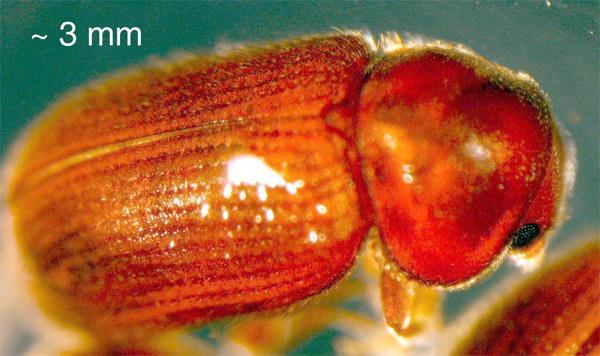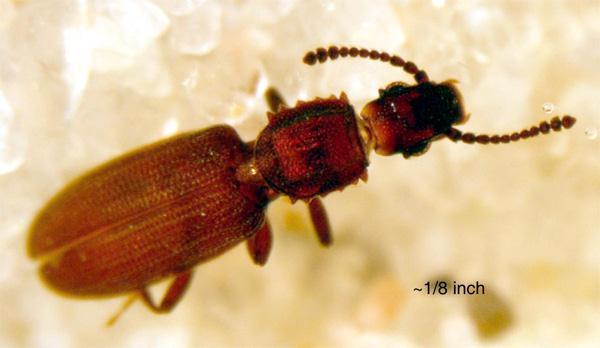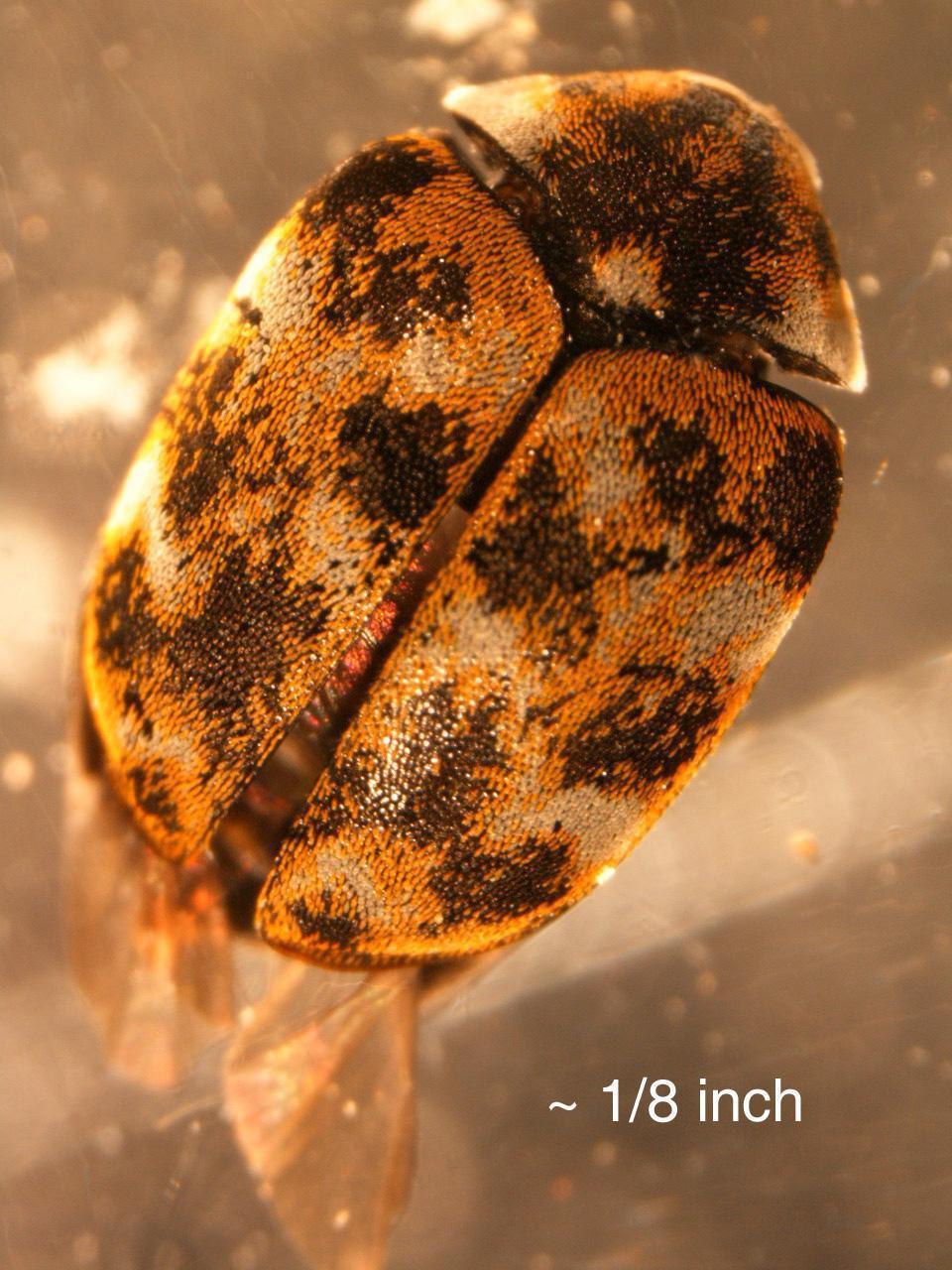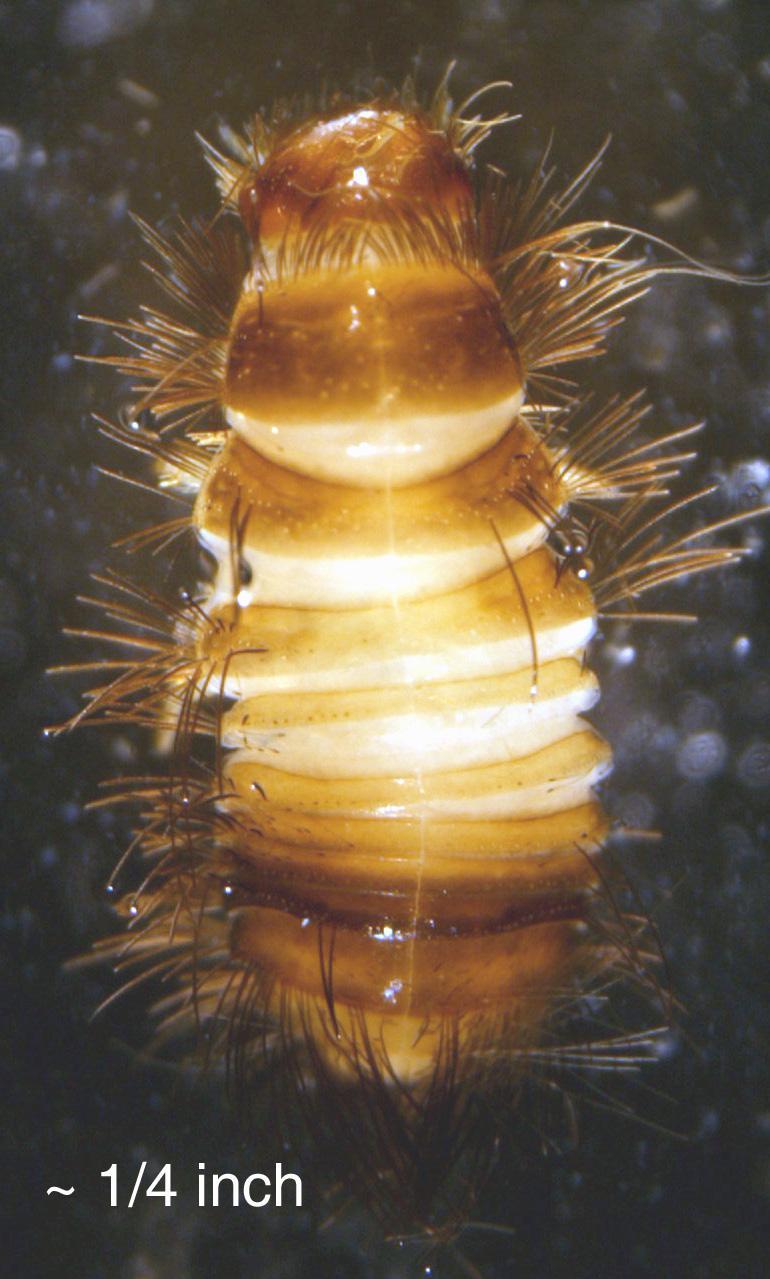Beetles in the Kitchen
Winter in the diagnostic lab is a time of many household pest submissions. There are a number of insects and arthropods that are considered household pests and are able to easily reproduce and prosper within the house. Many families of beetles attack food and furnishings in the home. Below are a few of the common ones received in the past year. These beetles aren’t considered a health concern, but can cause product damage and are considered nuisance pests.
Drugstore Beetle (Stegobium paniceum) – family Anobiidae

Anobiids are mainly tropical, with many boring into wood. The drugstore beetle can be found year-round in temperate climates where there is heat indoors. This species of beetles can eat almost everything. Items such as medicines, fabric items, spices, candy, and various foodstuffs are not safe from their mandibles. Both the larvae and the adults feed on these food sources. Sometimes the source can be difficult to identify because they can consume so many different items. Also, being attracted to lights, they may be found on a windowsill away from the infestation.
The adults are about 1/10 inch long. Anobiid beetles can be recognized by their ‘hooded’ prothorax, which covers their deflexed head, as seen in the photo. Females can lay 75 eggs. The larvae appear scarabaeiform (like little white grubs) and then form cocoons when pupating. The complete life cycle takes less than two months.
KSU extension has more information on kitchen pests in two publications: ‘Common Stored-Food Insect Pests’ (MF 2271; Jan 1998), found at http://www.bookstore.ksre.ksu.edu/pubs/MF2271.pdf. Accompanying this is the publication ‘Controlling Stored-Food Insects’ (MF 2270; Jan 1998) at http://www.bookstore.ksre.ksu.edu/pubs/MF2270.pdf.
Sawtoothed Grain Beetle (Oryzaephilus surinamensis) – family Silvanidae

A number of sawtoothed grain beetles have also been submitted this year. They are in the small family of flat grain beetles. This species has a worldwide distribution and are considered quite mobile and long-lived. The adults are prone to wander, though they seldom fly.
The sawtoothed grain beetle adults are up to 3 mm in length. The females lay 300-400 eggs, which hatch less than two weeks later. The larvae are whitish and elongated, with a brown-colored head. The larvae can penetrate packaging material and will attack damaged cereals or bore into whole grains. The larvae are after the germ of the seed. At room temperature, the whole life cycle can be completed in 80 days or less.
Information on control of pantry pests can be found at the links above.
Varied Carpet Beetle (Anthrenus verbasci) – family Dermestidae

One very common species sent to the KSU insect lab is the varied carpet beetle. This is a type of dermestid beetle, which are known for eating organic material of many types. There are many dermestids considered stored product pests. The beetles in the Anthrenus genus are called ‘carpet’ and ‘museum’ beetles.
Carpet beetles are about 1/8 inch in length and have elytra-covered scales. Females can lay 100+ eggs, which hatch in 1-2 weeks into pale-colored larvae with spear-shaped setae. The larvae molt several times, and may stay in this stage for two months to a year. The grown larvae are nearly ¼ inch long.

The varied carpet beetle larvae are often found feeding on the keratin of natural materials such as wool, furs, or carpets. They also infest stored products, where they are after the chitin of the insect bodies present there. The adults feed on pollen and nectar. They are attracted to light, and can enter a home from the outdoors.
A helpful reference for prevention and control of carpet beetles is found in a KSU extension publication, "Carpet Beetles" (L.D. Ent 319; May 2004) at: http://www.bookstore.ksre.ksu.edu/pubs/EP119.pdf. This is a good source of information about the carpet beetles.
Literature Cited:
Hill, D. 1990. Pests of Stored Products and Their Control. CRC Press, Inc: Boca Raton, FL. 274 p.
Lyon, W. Carpet Beetle. HYG-2103-97. http://ohioline.osu.edu/hyg-fact/2000/2103.html. Ohio State University Extension Factsheet.
Lyon, W. Cigarette and Drugstore Beetles. HYG-2083-97. http://ohioline.osu.edu/hyg-fact/2000/2083.html. Ohio State University Extension Factsheet.
December, 2007 -- Elizabeth Murray, Extension Entomology Diagnostician.